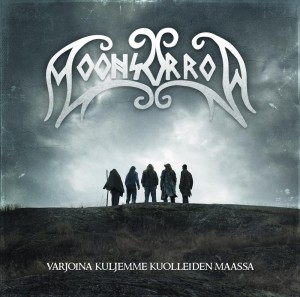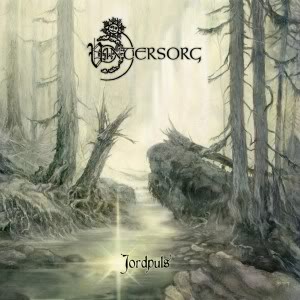In the past weeks since my year end list was posted, I’ve been enjoying a number of albums released in 2011 that I either overlooked, under appreciated at the time of release, or simply didn’t realize were out until recently. Although this tends to happen every year, I’m no less agitated by my oversights — it seems to suggest a failure on my part to be with it, to have the pulse of what is really great in metal at the moment. But on the other hand, I can only listen to so much at once, especially when I find myself drawn to repeated listenings of a few albums in a particular period of time. To counter this deficiency I listen to a few metal radio streams and select favorite metal radio shows, as well as sifting through the numerous best of 2011 lists to alert myself to music that may have missed my radar. Sometimes just seeing an album that I had ignored earlier reappear in a year end list will get me to give it another listen. Here’s the best of what I missed:
 Moonsorrow – Varjoina Kuljemme Kuolleiden Maassa:
Moonsorrow – Varjoina Kuljemme Kuolleiden Maassa:
Credit for this one goes to the Angry Metal Guy and his Top 10(ish) of 2011 list. I was vaguely aware that Moonsorrow had released a new album through the half-remembered mutterings of a friend, but I was not moved to check it out. Its not that I didn’t enjoy Moonsorrow, my first real Moonsorrow experience was seeing them live a few years back and I thoroughly enjoyed their show, thought they sounded great and proceeded to pick up a copy of their then new EP Tulimyrsky at the merch booth. What I loved in the live setting was not translating through on the recording, nor was anything from their 2007 album Viides Luku – Hävitetty. I suspect now it must’ve been a case of being in the wrong mindset — I wasn’t in the mood for ten to thirty minute long songs from a band that I (erroneously) perceived as supposedly being a blacker and bleaker Ensiferum. However, when AMG places an album at number one on his year end list, I tend to stow away any misgivings I may have had about a band, shut up and check out the album. Am I glad I did. I love this record, from start to finish, love it. I won’t do any personal year end list revisions, but had I heard this album before I contemplated my 2011 favorites I’d have no doubt that it would rank somewhere in the top ten. The standout track for me that had me hitting repeat over and over again was “Huuto”, whose main melody is introduced at the onset through chiming acoustic guitars. I’ll avoid an album review here (instead referring you to AMG’s review ), but instead will suggest to someone unfamiliar with Moonsorrow that this album is the perfect point of entry into their back catalog. The songs are trimmed down in length a bit from their past few releases, and while they are more immediate, they do not lack in songwriting quality or depth in the arrangements. Its an album with passionate blackened vocals, dark folk touched melodies, cinematic keyboards that drive the melodies, and overall epic scope. Enjoying this album has opened up the band’s past few releases for me, including the two mentioned above, and I’ve been enjoying those as well. Its a recurrence of what has become a theme for me lately: rediscovering bands I’d previously been unable to get into. I think that as a listener, your mindset and the timing of when you first listen to a band might have something to do with it, but more important than that is having the right point of entry into a band’s recorded output.
 Primordial – Redemption at the Puritan’s Hand:
Primordial – Redemption at the Puritan’s Hand:
Well I’m gonna have a hard time explaining this one. As with Moonsorrow except on a slightly more severe level, I could never get into Primordial despite all my best efforts through numerous listenings of random tracks on youtube, sampler cds, etc. over the years. I recall always enjoying the musicianship and arrangements, but the vocals were my stopping point. I just could not get into them. A few weeks ago, I took a listen to a few tracks from their 2011 release and found myself running into the same problem — that is until I put Alan Averill’s vocals into context. I started thinking about how he reminded me of Flogging Molly’s Dave King, who I’ve been a longtime fan of. I know it sounds stupid, but it worked. All of a sudden Averill’s vocals weren’t a problem, in fact, if anything they became more of a draw to me than the music because it reinforced to me that hey, this is an Irish black(ish) metal band, a true rarity. His vocal approach is unique, and in moments of clarity he sounds distinctly Irish in accent. I don’t know if my earlier attempts at enjoying this band’s music was just scuppered due to misplaced expectations or perhaps because I subconsciously wanted them to sound like Riverdance-meets-black metal. This is a good record, but I’ll have to say that I now prefer its predecessor To the Nameless Dead overall. While Redemption is not quite the point of entry record that Moonsorrow’s new one was, its standout track “Lain with the Wolf” is by far the band’s best song – one to You Tube if you’re at all remotely curious about this band. If its steady, churning build doesn’t move you, check your pulse.
 Hammers of Misfortune – 17th Street:
Hammers of Misfortune – 17th Street:
Credit where credit’s due, this was an album and band that I was introduced to through Lars Gotrich’s NPR Best Metal of 2011 list. Yes, despite my reservations about his and other similar year end lists, I did go through and take a listen to everything on it and this fantastic album by (the Metal Pigeon’s childhood hometown) San Francisco’s Hammers of Misfortune was the clear standout, an album that grabbed my interest because it touches upon the cornerstones of what I love in music in general. Namely, great songwriting, passionate vocals, and inventive arrangements. The hook-in was the track called “The Grain”, a song built around a soaring chorus that is immediately followed by an awesomely crunchy outro. Its simply one of the best songs I’ve heard all year. While the album doesn’t provide any other tracks that live up to its incredible standard, it does offer the widest variety of styles and approaches that I’ve heard on an album recently next to Nightwish’s Imaginaerum. The influences are pronounced; at times Thin Lizzy, Queen, and old Metallica blended through a prog filter into something that really does remind me of the Bay Area. The end result is a hard to categorize sound that is also difficult to describe in terms of relating them to contemporary bands, but that is the likely triumph here. Its therefore a bit pointless to try to talk someone into liking this record, just give it a chance and see if you like anything about it. You’ll need to give it multiple listens before it sets in as a whole album, and I can understand how some people will be unable to see the appeal. Its by far more rooted in a classic metal/hard rock approach than anything modern-ish, yet sounds more modern than most stuff out there today (if that holds any importance to you). A uniquely satisfying album.
 Vintersorg – Jordpuls:
Vintersorg – Jordpuls:
I have no excuse as to why I slept on this in 2011. This is an incredibly enjoyable, and fun(!) to listen to album. I actually obtained it upon release, gave it a cursory listen and never went back to it again. This is strange behavior for me because I actually am quite the Vintersorg fan, and above all his projects his solo albums are the treats I crave the most. Looking back now, I suspect that perhaps my initial indifference to Jordpuls was silently informed by my disappointment with the last Borknagar release (in case you didn’t know, Andreas Hedlund aka Vintersorg handles their vocals). I rather enjoyed Vintersorg’s 2007 album, Solens Rötter (“Roots of the Sun”), as it marked a return to Swedish lyrics and his Scandinavian folk influenced roots. This was a breath of fresh air after the utter proggy weirdness of the two albums that preceded it (good albums both, but bonkers weird). He sounded comfortable and at ease once again, the songs flowed better, and the shift towards simpler arrangements allowed his knack for excellent melodies to shine through again. It seems that with Jordpuls (“Pulse of the Earth”), he is building upon the foundations laid down with Solens Rötter and now has a better understanding of how to weave in the prog tendencies he loves in a more natural sounding way. I suppose this only makes sense if you understand what a jarring transition it was to listen to 1999’s Odenmarken’s Son, only to be greeted with the abrupt changes presented in its successors, 2000’s Cosmic Genesis, and 2002’s Visions From the Spiral Generator. Here’s hoping the upcoming Borknagar album can impress me just as much.
 High Spirits – Another Night:
High Spirits – Another Night:
Thanks to Joseph Schafer from Invisible Oranges for this recommendation. What an awesome record. It reminds me of the Scorpions (yes goddammit that’s a great thing) mixed with a cornucopia of 70s and 80s guitar rock. Hell even the cover, with its juxtaposition of classic looking band and album logos against a black framed scene of the Chicago cityscape at night, depicts the very scene I imagine when I hear the German legends’ “Big City Nights”. Apparently this is a one man project at its core, by a fellow named Chris Black who I’m led to believe handles all the instrumentation as well as vocal duties(?). Correct me if I’m wrong on that, but regardless, these are great songs played with a hard rock/metal spirit that seems to elude many of the new bands out there who are actively attempting to emulate the past. After reading Schafer’s write up of on Another Night and his earlier interview with Chris Black, I get the impression that this project exists for the simple reason that no one is making new music that sounds like this anymore. That’s a good enough reason as any to make a record that is more rockin’ (spelled as intended) than anything else I’ve heard in donkeys years. Good thing too, the mighty Scorpions are retiring soon, so someone needed to step up and continue to offer advice on what to do “when the daylight is falling down into the night”. You Tube “Full Power”, “Another Night in the City”, and “Do You Remember” — they’ll sell you on the record.

 The generous view on year-end/best-of lists of bloggers or websites is that they are often an exercise in an earnest, optimistic type of narcissism. I’ve done one myself, so I’m not guiltless in that aspect — but I’ve begun to realize that most of the lists currently being published are also exercises in varying, and scalable degrees of exclusionism. I say this because in the past two years major non-metal/indie oriented media outlets have taken it upon themselves to declare to their reading audiences what is the Best Metal of the Year. I’m referring to websites such as
The generous view on year-end/best-of lists of bloggers or websites is that they are often an exercise in an earnest, optimistic type of narcissism. I’ve done one myself, so I’m not guiltless in that aspect — but I’ve begun to realize that most of the lists currently being published are also exercises in varying, and scalable degrees of exclusionism. I say this because in the past two years major non-metal/indie oriented media outlets have taken it upon themselves to declare to their reading audiences what is the Best Metal of the Year. I’m referring to websites such as  It should be all too clear by now that Gotrich and Stosuy do not like traditional or power metal at all. To such a degree that they will willingly ignore popular, widely lauded albums that fall into those styles. To each his own right? Yes. But here’s my problem: these are two very influential writers. Their opinions as mentioned before are parroted around the web, and frankly, that’s where a lot of this type of discussion takes place. What concerns me is that these lists are being trotted out for readers and listeners not already familiar with metal in general. What Gotrich and Stosuy present to these types of audiences is a mere sliver of the many styles of metal that are actually available out there. An NPR listener might actually be capable of being interested in metal that is delivered with a clean, melodic vocalist, or be able to enjoy a record that isn’t washed out in synths and shoegaze influences (cheap shot I know). There are plenty of bands who put out quality releases that this hypothetical person could enjoy, but they might never know about them.
It should be all too clear by now that Gotrich and Stosuy do not like traditional or power metal at all. To such a degree that they will willingly ignore popular, widely lauded albums that fall into those styles. To each his own right? Yes. But here’s my problem: these are two very influential writers. Their opinions as mentioned before are parroted around the web, and frankly, that’s where a lot of this type of discussion takes place. What concerns me is that these lists are being trotted out for readers and listeners not already familiar with metal in general. What Gotrich and Stosuy present to these types of audiences is a mere sliver of the many styles of metal that are actually available out there. An NPR listener might actually be capable of being interested in metal that is delivered with a clean, melodic vocalist, or be able to enjoy a record that isn’t washed out in synths and shoegaze influences (cheap shot I know). There are plenty of bands who put out quality releases that this hypothetical person could enjoy, but they might never know about them.